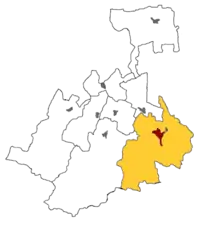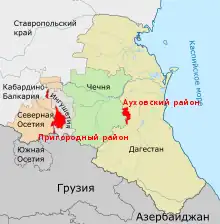East Prigorodny conflict
The East Prigorodny conflict, also referred to as the Ossetian–Ingush conflict,[lower-alpha 1] was an inter-ethnic conflict in the eastern part of the Prigorodny District in the Republic of North Ossetia–Alania, which started in 1989 and developed, in 1992, into a brief ethnic war between local Ingush and Ossetian paramilitary forces.[3]
| East Prigorodny conflict | |||||||
|---|---|---|---|---|---|---|---|
| Part of the Post-Soviet conflicts | |||||||
 Prigorodny District in North Ossetia–Alania | |||||||
| |||||||
| Belligerents | |||||||
|
|
| ||||||
| Commanders and leaders | |||||||
|
| - | ||||||
| Casualties and losses | |||||||
|
192 dead[2] 379 wounded[2] |
409 dead[3] 457 wounded[4] | ||||||
|
30,000–60,000 Ingush refugees[5] 9,000 Ossetian refugees[3] | |||||||
Origins of the conflict
Imperial and early Soviet era
The present conflict emerges from the policies of both Imperial and Soviet governments, which exploited ethnic differences to further their own ends, namely the perpetuation of central rule and authority. Tsarist policy in the North Caucasus generally favored Ossetians, who inhabited an area astride the strategically important Georgian Military Highway, a key link between Russia proper and her Transcaucasian colonies.
In addition, the Ossetians were one of the few friendly peoples in a region that for much of the nineteenth century bitterly resisted Russian rule; a majority of Ossetians shared the same Eastern Orthodox Christian faith with Russians (while a minority are Sunni Muslim), while the majority of the other ethnic groups of the North Caucasus were Muslim. Russian authorities also conducted population transfers of native people in the area at will and brought in large numbers of Terek Cossacks.
Under the Soviets, local Cossacks (many of the early members of the Terek Cossacks were Ossetians[6]) were punished for their support of anti-Soviet White forces during the Russian Civil War (1918–1921) and banished from the area, including from the Prigorodnyi region which was given to the Ingush, ostensibly for their support of the Red or Bolshevik forces during the conflict. Soviet administrators often arbitrarily created territorial units in the North Caucasus, thereby enhancing differences by splitting apart like peoples or fostering dependence by uniting different groups.
In January 1920, the Autonomous Mountain Soviet Socialist Republic, referred to as the "Mountaineers Republic," was formed, with its capital in Vladikavkaz. Initially, the "Mountaineers Republic," included the Kabards, Chechens, Ingush, Ossetians, Karachai, Cherkess, and Balkars, but it quickly began to disintegrate and new territorial units were created. In 1924, the Ingush were given their own territorial unit that included the Prigorodnyi region. In 1934, the Ingush were merged territorially with the Chechens; in 1936 this territory was formed into the Checheno-Ingush ASSR with its capital in Grozny. The Prigorodnyi region still remained within the Chechen–Ingush entity.[3][7]
In 1944, near the end of World War II, the Ingush and the Chechen peoples were accused of collaborating with the Nazis, and by order of Joseph Stalin, the whole population of Ingush and Chechens were deported to Central Asia and Siberia. Soon after, the depopulated Prigorodny district was transferred to North Ossetia.[8]
Post-WW2 tensions and Soviet collapse

In 1957, the repressed Ingush and Chechens were allowed to return to their native land and the Checheno-Ingush Republic was restored, with the Prigorodny district maintained as part of North Ossetia. Soviet authorities attempted to prevent Ingush from returning to their territory in Prigorodny district; however, Ingush families managed to move in, purchase houses back from the Ossetians and resettled the district in greater numbers.[8]
This gave rise to the idea of "restoring historical justice" and "returning native lands", among the Ingush population and intelligentsia, which contributed to the already existing tensions between ethnic Ossetians and Ingush. Between 1973 and 1980 the Ingush voiced their demands for the reunification of the Prigorodny district with Ingushetia by staging various protests and meetings in Grozny.
The tensions increased in early 1991, during the collapse of the Soviet Union, when the Ingush openly declared their rights to the Prigorodny district according to the Soviet law adopted by the Supreme Soviet of the USSR on April 26, 1991; in particular, the third and the sixth article on "territorial rehabilitation." The law gave the Ingush legal grounds for their demands, which caused serious turbulence in a region in which many people had free access to weapons, resulting in an armed conflict between ethnic Ingush population of the Prigorodny district and Ossetian armed militias from Vladikavkaz.[9]
Armed conflict
Ethnic violence rose steadily in the area of the Prigorodny district, to the east of the Terek River, despite the introduction of 1,500 Soviet Internal Troops to the area.
During the summer and early autumn of 1992, there was a steady increase in the militancy of Ingush nationalists. At the same time, there was a steady increase in incidents of organized harassment, kidnapping and rape against Ingush inhabitants of North Ossetia by their Ossetian neighbours, police, security forces and militia.[3] Ingush fighters marched to take control over Prigorodny District and on the night of October 30, 1992, open warfare broke out, which lasted for a week. The first people killed were respectively Ossetian and Ingush militsiya staff (as they had basic weapons). While Ingush militias were fighting the Ossetians in the district and on the outskirts of the North Ossetian capital Vladikavkaz, Ingush from elsewhere in North Ossetia were forcibly evicted and expelled from their homes. Russian OMON forces actively participated in the fighting and sometimes led Ossetian fighters into battle.[3]
On October 31, 1992, armed clashes broke out between Ingush militias and North Ossetian security forces and paramilitaries supported by Russian Interior Ministry (MVD) and Army troops in the Prigorodny District of North Ossetia. Although Russian troops often intervened to prevent some acts of violence by Ossetian police and republican guards, the stance of the Russian peacekeeping forces was strongly pro-Ossetian,[8] not only objectively as a result of its deployment, but subjectively as well. The fighting, which lasted six days, had at its root a dispute between ethnic Ingush and Ossetians over the Prigorodnyi region, a sliver of land of about 978 square kilometers over which both sides lay claim. That dispute has not been resolved, nor has the conflict. Both sides have committed human rights violations. Thousands of homes have been wantonly destroyed, most of them Ingush. More than one thousand hostages were taken on both sides, and as of 1996 approximately 260 individuals-mostly Ingush-remain unaccounted for, according to the Procuracy of the Russian Federation. Nearly five hundred individuals were killed in the first six days of conflict. Hostage-taking, shootings, and attacks on life and property continued at least until 1996.[10] President Boris Yeltsin issued a decree that the Prigorodny district was to remain part of North Ossetia on November 2.
Casualties
Total dead as of June 30, 1994: 644.[11]
| Ossetian | 151 |
| Ingush | 302 |
| Other Nationalities | 25 |
| North Ossetian Ministry of the Interior | 9 |
| Russian Ministry of Defense | 8 |
| Russian Ministry of the Interior, Internal Troops | 3 |
| Ossetian | 9 |
| Ingush | 3 |
| Other Nationalities | 2 |
| Unknown Nationalities | 12 |
| Unified Investigative Group, Ministry of the Interior | 1 |
| Ossetian | 40 |
| Ingush | 333 |
| Other nationalities | 21 |
| Unknown nationalities | 30 |
| North Ossetian Ministry of the Interior | 9 |
| Ingush Ministry of the Interior | 5 |
| Russian Ministry of Defense | 3 |
| Russian Ministry of the Interior, Internal Troops | 4 |
| Unified Investigative Group, Russian Ministry of the Interior | 8 |
| Ossetian | 6 |
| Ingush | 3 |
| Other nationalities | 7 |
| Russian Ministry of Defense | 1 |
| Russian Ministry of the Interior, Internal Troops | 2 |
| Unified Investigative Group, Russian Ministry of the Interior | 4 |
Aftermath
According to Human Rights Watch:[3][7]
The fighting was the first armed conflict on Russian territory after the collapse of the Soviet Union. When it ended after the deployment of Russian troops, most of the estimated 34,500–64,000 Ingush residing in the Prigorodnyi region and North Ossetia as a whole had been forcibly displaced by Ossetian forces, often supported by Russian troops. There are no authoritative figures for the number of Ingush forcibly evicted from the Prigorodnyi region and other parts of North Ossetia, because there were no accurate figures for the total pre-1992 Ingush population of Prigorodnyi and North Ossetia. Ingush often lived there illegally and thus were not counted by a census. Thus the Russian Federal Migration Service counts 46,000 forcibly displaced from North Ossetia, while the Territorial Migration Service of Ingushetiya puts the number at 64,000. According to the 1989 census 32,783 Ingush lived in the North Ossetian ASSR; three years later the passport service of the republic put the number at 34,500. According to the migration service of North Ossetia, about 9,000 Ossetians were forced to flee the Prigorodnyi region and seek temporary shelter elsewhere; the majority have returned.[3][7]
It is estimated that between 1994 and 2008, around 25,000 of the Ingush people returned to Prigorodny District while some 7,500 remained in Ingushetia.[12]
On October 11, 2002, the presidents of Ingushetia and North Ossetia signed an agreement "promoting cooperation and neighborly relations".
See also
Notes
References
- "The Localized Geopolitics of Displacement and Return in Eastern Prigorodnyy Rayon, North Ossetia" (PDF). colorado.edu. Archived (PDF) from the original on 23 September 2015. Retrieved 19 July 2015.
- Осетино‑ингушский конфликт: хроника событий (in Russian). Inca Group "War and Peace". November 8, 2008. Archived from the original on May 20, 2011. Retrieved June 4, 2010.
- Russia: The Ingush–Ossetian Conflict in the Prigorodnyi Region (Paperback) by Human Rights Watch Helsinki Human Rights Watch (April 1996) ISBN 1-56432-165-7
- Prague Watchdog Report, published July 28, 2006
- "The Secret History of Beslan". Archived from the original on 2017-04-22. Retrieved 2017-04-21.
- Wixman. The Peoples of the USSR. p. 52
- "Russia". hrw.org. Archived from the original on 25 March 2017. Retrieved 28 June 2015.
- A. Dzadziev. The Ingush–Ossetian conflict: The Roots and the Present Day // Journal of Social and Political Studies. 2003, _ 6 (24)
- The Ossetian–Ingush Conflict: Perspectives of Getting out of Deadlock Moscow. Russian Independent Institute of Social and National Problems, Professional Sociological Assiciation. ROSSPEN. 1998. p.30
- "Russia". Archived from the original on 2017-02-07. Retrieved 2019-09-05.
- Raion Chrezvychainogo Polozheniya (Severnaya Osetiya I Ingushetiya), (The Region of Emergency Rule: North Ossetia and Ingushetiya,) Vladikavkaz, North Ossetia, 1994, p. 63. This compilation of reports, statistics, and documents is published by the Temporary Administration.
- "Russian Federation: Imminent forcible eviction in Ingushetia" (PDF). Archived (PDF) from the original on 2017-04-22. Retrieved 2017-08-26.
Bibliography
- Volkova, N. G. (1974). Gardanov, V. K. (ed.). Этнический состав населения Северного Кавказа в XVIII — начале XX века [Ethnic composition of the population of the North Caucasus in the 18th – early 20th centuries] (in Russian). Moskva: Nauka. pp. 1–276.